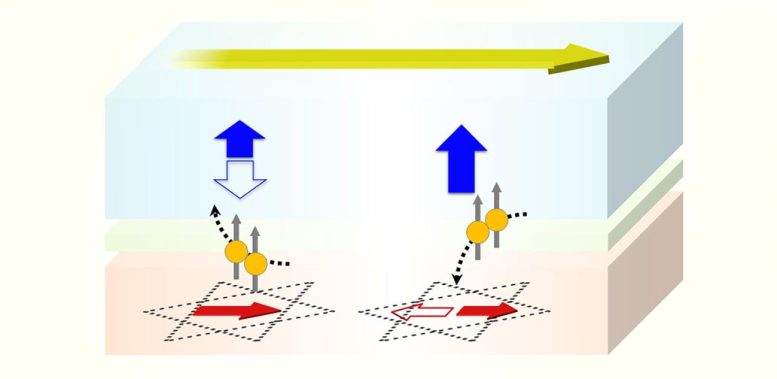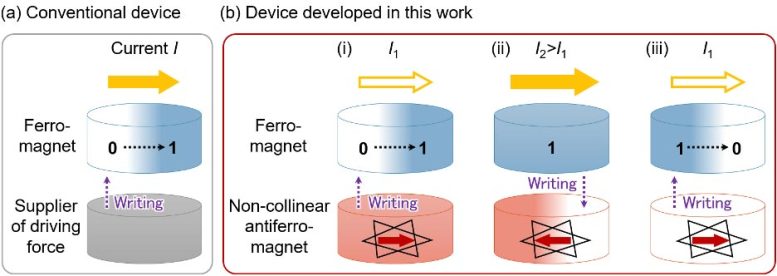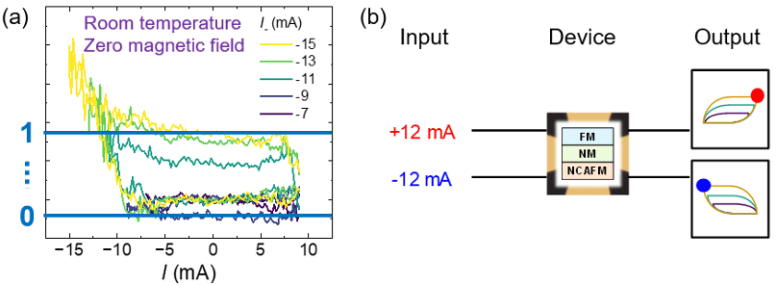AI is evolving at an incredible pace, but its growing energy demands pose a major challenge. Enter spintronic devices—new technology that mimics the brain's efficiency by integrating memory and processing.
Scientists in Japan have now developed a groundbreaking spintronic device that allows for electrical control of magnetic states, drastically reducing power consumption. This breakthrough could revolutionize AI hardware by making chips far more energy-efficient, mirroring the way neural networks function.
Spintronic Devices: A Game-Changer for AI Hardware
AI is rapidly transforming industries, but as these technologies evolve, so does their demand for power. To sustain further advancements, AI chips must become more energy efficient.
This is where spintronic devices come in. By integrating memory and computing functions—similar to how the human brain operates—they offer a promising foundation for low-power AI chips.
Now, researchers from Tohoku University, the National Institute for Materials Science, and the Japan Atomic Energy Agency have developed a groundbreaking spintronic device. This new technology enables the electrical mutual control of non-collinear antiferromagnets and ferromagnets, allowing for efficient switching of magnetic states. In practical terms, it can store and process information using significantly less energy, much like a brain-inspired AI chip.
This breakthrough could pave the way for a new generation of AI hardware that is both highly efficient and energy-saving. The findings were published in Nature Communications on February 5, 2025.

Revolutionizing AI with Multi-State Magnetic Control
"While spintronic research has made significant strides in controlling magnetic order electrically, most existing spintronic devices separate the role of the magnetic material to be controlled and the material providing the driving force," says Tohoku University's Shunsuke Fukami, who supervised the research.
These devices have a fixed operation scheme once fabricated, typically switching information from "0" to "1" in a binary fashion. However, the new research team's breakthrough offers a major innovation in electrically programmable switching of multiple magnetic states.

Harnessing the Power of the Magnetic Spin Hall Effect
Fukami and his colleagues employed the non-collinear antiferromagnet Mn3Sn as the core magnetic material. By applying an electrical current, Mn3Sn generates a spin current that drives the switching of a neighboring ferromagnet, CoFeB, through a process known as the magnetic spin Hall effect. Not only does the ferromagnet respond to the spin-polarized current, but it also influences the magnetic state of Mn3Sn, enabling the electrical mutual switching between the two materials.
In their proof-of-concept experiment, the team demonstrated that information written to the ferromagnet can be electrically controlled via the magnetic state of Mn3Sn. By adjusting the set current, they were able to switch the magnetization of CoFeB in different traces representing multiple states. This analog switching mechanism, where the polarity of the current can change the sign of the information written, is a key operation in neural networks, mimicking the way synaptic weights (analog values) function in AI processing.

Paving the Way for Energy-Efficient AI Chips
"This discovery represents an important step toward the development of more energy-efficient AI chips. By realizing the electrical mutual switching between a non-collinear antiferromagnet and a ferromagnet, we have opened new possibilities for current-programmable neural networks," said Fukami. "We are now focusing on further reducing operating currents and increasing readout signals, which will be crucial for practical applications in AI chips."
The team's research opens new pathways for improving the energy efficiency of AI chips and minimizing their environmental impacts.
Reference: "Electrical mutual switching in a noncollinear-antiferromagnetic–ferromagnetic heterostructure" by Ju-Young Yoon, Yutaro Takeuchi, Ryota Takechi, Jiahao Han, Tomohiro Uchimura, Yuta Yamane, Shun Kanai, Jun'ichi Ieda, Hideo Ohno and Shunsuke Fukami, 5 February 2025, Nature Communications.
DOI: 10.1038/s41467-025-56157-6
News
Fever-Proof Bird Flu Variant Could Fuel the Next Pandemic
Bird flu viruses present a significant risk to humans because they can continue replicating at temperatures higher than a typical fever. Fever is one of the body’s main tools for slowing or stopping viral [...]
What could the future of nanoscience look like?
Society has a lot to thank for nanoscience. From improved health monitoring to reducing the size of electronics, scientists’ ability to delve deeper and better understand chemistry at the nanoscale has opened up numerous [...]
Scientists Melt Cancer’s Hidden “Power Hubs” and Stop Tumor Growth
Researchers discovered that in a rare kidney cancer, RNA builds droplet-like hubs that act as growth control centers inside tumor cells. By engineering a molecular switch to dissolve these hubs, they were able to halt cancer [...]
Platelet-inspired nanoparticles could improve treatment of inflammatory diseases
Scientists have developed platelet-inspired nanoparticles that deliver anti-inflammatory drugs directly to brain-computer interface implants, doubling their effectiveness. Scientists have found a way to improve the performance of brain-computer interface (BCI) electrodes by delivering anti-inflammatory drugs directly [...]
After 150 years, a new chapter in cancer therapy is finally beginning
For decades, researchers have been looking for ways to destroy cancer cells in a targeted manner without further weakening the body. But for many patients whose immune system is severely impaired by chemotherapy or radiation, [...]
Older chemical libraries show promise for fighting resistant strains of COVID-19 virus
SARS‑CoV‑2, the virus that causes COVID-19, continues to mutate, with some newer strains becoming less responsive to current antiviral treatments like Paxlovid. Now, University of California San Diego scientists and an international team of [...]
Lower doses of immunotherapy for skin cancer give better results, study suggests
According to a new study, lower doses of approved immunotherapy for malignant melanoma can give better results against tumors, while reducing side effects. This is reported by researchers at Karolinska Institutet in the Journal of the National [...]
Researchers highlight five pathways through which microplastics can harm the brain
Microplastics could be fueling neurodegenerative diseases like Alzheimer's and Parkinson's, with a new study highlighting five ways microplastics can trigger inflammation and damage in the brain. More than 57 million people live with dementia, [...]
Tiny Metal Nanodots Obliterate Cancer Cells While Largely Sparing Healthy Tissue
Scientists have developed tiny metal-oxide particles that push cancer cells past their stress limits while sparing healthy tissue. An international team led by RMIT University has developed tiny particles called nanodots, crafted from a metallic compound, [...]
Gold Nanoclusters Could Supercharge Quantum Computers
Researchers found that gold “super atoms” can behave like the atoms in top-tier quantum systems—only far easier to scale. These tiny clusters can be customized at the molecular level, offering a powerful, tunable foundation [...]
A single shot of HPV vaccine may be enough to fight cervical cancer, study finds
WASHINGTON -- A single HPV vaccination appears just as effective as two doses at preventing the viral infection that causes cervical cancer, researchers reported Wednesday. HPV, or human papillomavirus, is very common and spread [...]
New technique overcomes technological barrier in 3D brain imaging
Scientists at the Swiss Light Source SLS have succeeded in mapping a piece of brain tissue in 3D at unprecedented resolution using X-rays, non-destructively. The breakthrough overcomes a long-standing technological barrier that had limited [...]
Scientists Uncover Hidden Blood Pattern in Long COVID
Researchers found persistent microclot and NET structures in Long COVID blood that may explain long-lasting symptoms. Researchers examining Long COVID have identified a structural connection between circulating microclots and neutrophil extracellular traps (NETs). The [...]
This Cellular Trick Helps Cancer Spread, but Could Also Stop It
Groups of normal cbiells can sense far into their surroundings, helping explain cancer cell migration. Understanding this ability could lead to new ways to limit tumor spread. The tale of the princess and the [...]
New mRNA therapy targets drug-resistant pneumonia
Bacteria that multiply on surfaces are a major headache in health care when they gain a foothold on, for example, implants or in catheters. Researchers at Chalmers University of Technology in Sweden have found [...]
Current Heart Health Guidelines Are Failing To Catch a Deadly Genetic Killer
New research reveals that standard screening misses most people with a common inherited cholesterol disorder. A Mayo Clinic study reports that current genetic screening guidelines overlook most people who have familial hypercholesterolemia, an inherited disorder that [...]





















